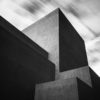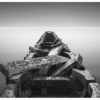Although I wouldn’t label all of my work as minimalist, it is heavily informed by many of the same principles. Perhaps this comes from my background in graphic design. I appreciate the elegance of minimalism in the same way an engineer would appreciate the simplicity and efficiency of a well-designed machine with no redundant or extraneous parts. However, minimalism seems to be a style that many people don’t get. Some may view it as purely esoteric, but I also wonder if people mistake simplicity for lack, failing to see just how much artistry actually goes into a concise composition solution. Minimalist art is not the same as abstract art, but they do have areas of overlap. Since I’ve previously written much on the subject of abstraction, I’ll try to avoid repeating similar concepts. This post is the first of a two-part series that I hope will offer some insight into the craftsmanship and creativity that goes into paring down a composition of all nonessential components, particularly within the medium of photography. I hope to convince you of the elegance of a reductionist approach to composition, and that achieving simplicity takes much more finesse than you might expect.

The Art of Exclusion
It has been said that photography is an art of exclusion. I don’t typically relate to broad generalizations, but I wholeheartedly concur with this assessment of the medium. I’m hard pressed think of any other visual art form that so consistently presents reality as an obstacle to the artist; as a problem to be solved.
This dilemma might be easier to explain with a quick analogy: If a painter is working on a scene with an old barn on a grassy field and doesn’t like the look of the highway bridge in the background, he simply doesn’t paint it into the scene. A photographer approaching the same scene has to be a little more innovative because her camera is going to capture whatever she allows in front of it. To exclude unwanted elements in the composition requires good problem solving skills and a solid understanding of the different techniques photographers use to organize a scene: focal length, depth-of-field, motion blur, proximity, angle of view, etc. Unfortunately, even with the skilled implementation of the above techniques, photographers are sometimes forced to compromise our desired or ideal composition to keep unwanted elements out of the shot. [I’m well aware that many modern photographers are incorporating newer technologies of digital manipulation and multi-image composites as additional ways of solving such problems, but that is a whole different discussion]

My image Orpheus is a simple composition in that there are few visual elements. However, the suggested relationship between the two primary subjects (the figure and the moon) does a lot to tell a story and create movement within the empty spaces. The diagonal lines in the architecture cross and complement the implied diagonal line where your eye travels back and forth between the figure to the moon, creating a subtle tension (see Fig. 1 below for clarity). The empty space (sky) is needed to balance out the intricate details in the relief sculptures of the building’s façade so that the viewer is not overwhelmed with detail and the intent of the image remains clear. Taller portions of the same building, along with modern skyscrapers behind it, were hidden from view by moving closer to the base of the building so that they disappeared behind the horizon of the front wall (see Fig. 2 below for example).
The Art of Organization and Arrangement
Photographers are tasked with sorting out the various details that are physically present in a scene and trying to create order from chaos. We use our instincts along with the elements of art and the principles of design as guides to achieve organization. We look for potential relationships between each element in the frame and try to bring out contrasts or harmonies, to create tension or resolution to varying degrees. That is the art of it. The photographer isolates and emphasizes a subject through exclusion and organization to draw your attention to a specific characteristic or relationship. I think that these unspoken choices—the process of simplification and refinement—is largely under-appreciated by the average viewer when considering the final image. Many take for granted the fact that, while cameras are indeed capable of capturing reality, a skilled photographer is doing so much more than simply documenting what is there. He is, in a sense, creating his own reality. In the same way that withholding specific details can distort truth, the image a photographer presents is not necessarily a representation of reality. Photographer Richard Avedon said it best:
“All photographs are accurate. None of them is the truth.”

Above is a deconstruction of Orpheus which illustrates how my mind was organizing the scene when I composed this image. I assessed the visual weight of different components by breaking things up into chunks of positive and negative space (as seen by the black and white overlays), as well as dominant and sub dominant scene elements (outlined in green). The red lines demonstrate the movement and tension created by the actual and implied lines in the image. What isn’t shown in this deconstruction of my final image are all the potentially distracting scenic elements that were excluded to simplify the composition into such a concise design. Examine the image below:

Notice the smokestack, third and fourth stories of the theatre, and the surrounding modern buildings in the area where I was shooting. To my eye these things would have only complicated my image, so they were excluded by carefully choosing my point of view. The subject is circled in green so you can see where I was working. I couldn’t move the buildings, or the moon, but I could move myself in relationship to them, therefore altering their relationship to each other.
Next time you look at a photograph, consider the different components that are in the scene. Study the relationships or contrasts suggested between those components. If the photographer included them they may have an important role in the image and you should spend some time exploring what that may be. Analyze them as clues to what the artist is communicating to you. Pay attention to which elements the photographer emphasizes through proportion, scale, focus, leading line, contrast, etc. Don’t take for granted the possibility that perhaps just outside the frame existed some physical reality that the photographer excluded to clarify her message and enhance the aesthetic experience. Remember you are not necessarily viewing reality, but a carefully constructed creative expression of real things. Consider that even if you were to visit the exact location where the photographer made the image, it would not necessarily have the same visual impact as the finished photograph. Don’t be deceived by simplicity. Rather, appreciate the elegance of it.


